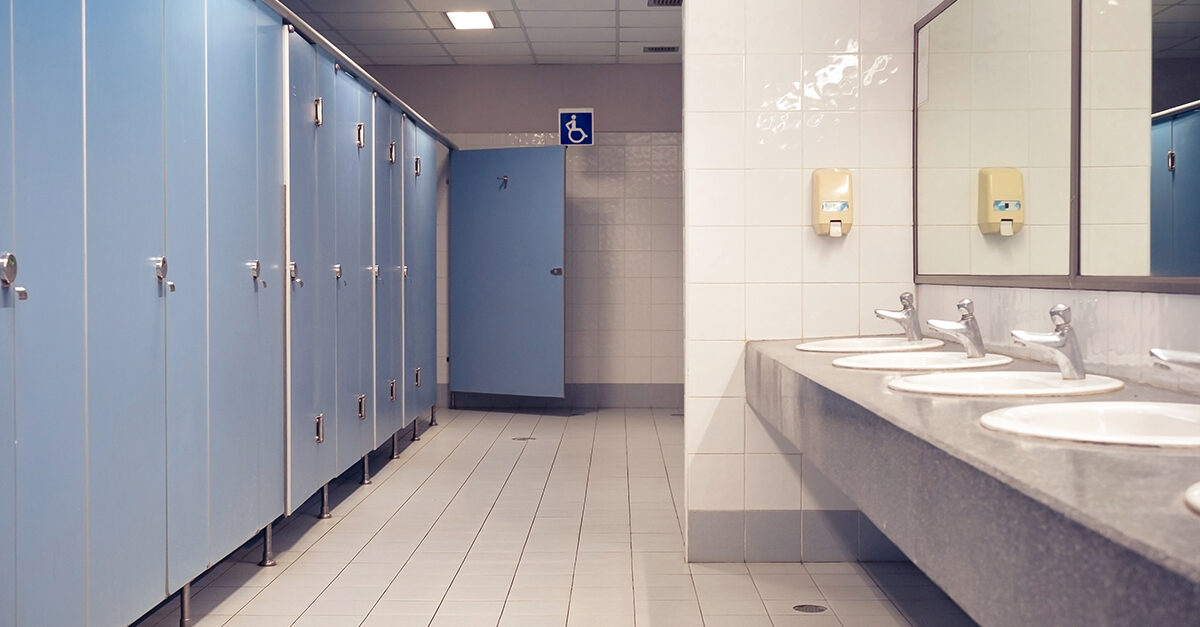In the midst of the COVID-19 pandemic, maintaining high-traffic common areas within a facility such as restrooms is critical. According to a study in Applied and Environmental Microbiology, 77,000 distinct types of bacteria and viruses exist in restrooms. Due to the aerosol effect that occurs when a toilet is flushed with the lid open, harmful bacteria can easily spread throughout a restroom.
However, the toilet is not a restroom’s most unsanitary place. Many different surfaces harbor bacteria. In addition to toilets, it’s important to clean and disinfect the following restroom high-touch surfaces to prevent germ transmission:
1. Door handles
Door handles are oftentimes unavoidable. With each entry and exit, germs are transferred from restroom users’ hands to the handle and vice versa. Cleaning and disinfecting restroom door handles regularly will help mitigate the spread of germs throughout facilities.
2. Dispensers and dryers
Not all restrooms include touchless soap and paper towel dispensers. Dispensers without touchless features may harbor more bacteria and viruses. Clean and disinfect “push” dispensers if touchless installation is not feasible. Hot air dryers have also been shown to spread germs throughout a restroom.
For example, a 2018 study in Applied and Environmental Microbiology found that hot-air hand dryers collect bacteria from the air and spread it onto freshly washed hands. Another study in the Journal of Applied Microbiology found that jet-air dryers spread 60 times more bacteria than warm dryers and 1,300 times more than paper towels.
Providing paper towel dispensers can be one way to help patrons and employees dry their hands without spreading germs. Consider placing the paper towel dispenser near the exit so they can use a paper towel to grab the door handle when exiting a restroom. Install a trashcan next to the exit so they can easily throw the used paper towel away before leaving the restroom.
3. Light switches
In some restrooms, users may have to manually turn lights on and off, especially if the restroom has only one stall. With a focus on door handles, floors, and toilets, light switches can often be overlooked when cleaning and disinfecting high-touch surfaces in restrooms. Make sure they receive proper attention too.
4. Grab rails
Rails should be cleaned frequently by using a soft microfiber cloth, avoiding abrasive tools and solutions. For example, using steel wool or mineral acids and bleach may cause the rails to rust. Additionally, if you use disinfectant solution, follow proper label instructions. It’s important to know the dwell times of disinfectants as well as if the solution should be wiped off or can air dry.
5. Restroom stalls:
When cleaning door latches, toilets, and floors, don’t ignore restroom stall walls, which may be covered in bacteria spread from toilet plume. Stall walls can accumulate germs and are often overlooked.
Restroom cleaning best practices
When deep cleaning and disinfecting high-touch surfaces in restrooms, it’s critical that facilities follow best practices, such as:
- Using high-pressure cleaning and extraction: High-pressure cleaning removes buildup that brushes can’t reach and eliminates the need to touch contaminated surfaces. It removes soil and dirty water, which helps to minimize cross-contamination and odor-causing bacteria. Afterward, it’s best to extract any leftover soils to prepare the surface for disinfection. If facility managers aren’t able to high-pressure clean in-house, professional services are available.
- Cleaning before disinfecting: Proper disinfection requires the removal of heavy soils that can become embedded in restrooms before disinfectant is applied. Cleaning will decrease dirt, germs and other impurities on high-touch surfaces, and disinfecting will kill or inactivate the germs on the surface. If high-pressure cleaning and extraction is not available, using separate brushes, hand tools, microfiber wipes, and a dual-chamber mop bucket will help reduce cross-contamination.
- Staying educated and following instructions: Aside from using proper cleaning protocols, it’s important to stay educated on the products used and follow manufacturers’ directions. For example, some disinfectants may have a contact time of 10 minutes, while others may only require three minutes. Using disinfectants and other products on the U.S. Environmental Protection Agency’s (EPA) List-N that are effective against SARS-CoV-2, the virus that causes COVID-19, is important. Additionally, adhere to chemical recommendations or dilutions to achieve the highest level of clean.
Following best practices that address cleaning high-touch points in high-traffic areas such as restrooms is important to help limit the spread of germs throughout a facility. As businesses work hard to provide clean and safe facilities in the COVID-19 era, it’s more important than ever to establish and adhere to strict cleaning protocols.



